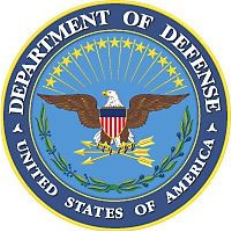
Department of Defense
Mission Engineering Guide
Version 2.0
October 1, 2023
Office of the Under Secretary of Defense
for Research and Engineering
Mission Capabilities
Washington, D.C.
Distribution Statement A. Approved for public release. Distribution is unlimited.
DOPSR Case No. 23-S-3518.
Department of Defense
Mission Engineering Guide
Office of the Under Secretary of Defense for Research and Engineering
3030 Defense Pentagon
Washington, DC 20301
https://ac.cto.mil/mission-engineering/
Distribution Statement A. Approved for public release. Distribution is unlimited.
DOPSR Case No. 23-S-3518.


iv
CONTENTS
1.0 _Introduction............................................................................................................................................ 1
1.1 Background ......................................................................................................................................... 1
1.2 Purpose of the Mission Engineering Guide ......................................................................................... 1
2.0 _Mission Engineering .............................................................................................................................. 3
2.1 Overview ............................................................................................................................................. 3
2.2 Mission Engineering Methodology ..................................................................................................... 4
2.3 Considerations ..................................................................................................................................... 6
2.3.1 Digital Engineering in Mission Engineering ................................................................................ 6
2.3.2 Robustness and Transparency Across the Mission Engineering Process ..................................... 6
2.3.3 Reuse––Curation of Data and Products ........................................................................................ 7
3.0 _Mission Problem or Opportunity ........................................................................................................... 9
3.1 Identify Mission and Mission Engineering Purpose ........................................................................... 9
3.2 Determine Investigative Questions ................................................................................................... 10
3.3 Identify and Engage with Stakeholders ............................................................................................. 11
4.0 _Mission Characterization ..................................................................................................................... 12
4.1 Develop Mission Context .................................................................................................................. 13
4.2 Define Mission Measures and Metrics .............................................................................................. 14
5.0 _Mission Architectures .......................................................................................................................... 18
5.1 Mission Threads ................................................................................................................................ 19
5.2 Mission Engineering Threads ........................................................................................................... 20
5.3 Develop Baseline and Alternative Mission Threads and Mission Engineering Threads .................. 22
6.0 _Mission Engineering Analysis ............................................................................................................. 24
6.1 Complete Design of Analysis ............................................................................................................ 24
6.1.1 Develop and Organize Evaluation Framework (Run Matrix)..................................................... 24
6.1.2 Identify Computational Methodology and Simulation Tools ..................................................... 25
6.1.3 Organize and Review Datasets ................................................................................................... 26
6.2 Execute Models, Simulations, and Analysis ..................................................................................... 26
6.2.1 Execute and Analyze the Baseline .............................................................................................. 27
6.2.2 Adjust the Run Matrix (as Needed) ............................................................................................ 27
6.2.3 Execute and Analyze the Alternative Mission Approaches ........................................................ 27
6.2.4 Validate the Fidelity of Analytic Results .................................................................................... 27
v
6.3 Adjust Mission Threads and Mission Engineering Threads ............................................................. 28
7.0 _Results and Recommendations ............................................................................................................ 29
8.0 _Summary .............................................................................................................................................. 31
9.0 _Appendix ............................................................................................................................................. 32
9.1 Mission Engineering Glossary .......................................................................................................... 32
9.2 Abbreviation List .............................................................................................................................. 36
9.3 References ......................................................................................................................................... 38

1
1.0 _INTRODUCTION
1.1 Background
As the Department of Defense works to provide the Joint Force with the necessary capabilities,
technologies, and systems to successfully execute missions, practitioners of mission engineering
can leverage the process described in this guide to help identify and analyze gaps as well as
determine which capabilities, technologies, and systems can improve mission outcomes.
Increasingly, the Department is emphasizing a mission-focused approach to operations and support
activities to ensure resources are aligned to accomplish organizational goals. Mission engineering
is a process that helps the Department better understand and assess impacts to mission outcomes
based on changes to systems, threats, operational concepts, environments, and mission
architectures. Mission-based, data-driven outputs help to inform acquisition, research and
development, and concepts of operation, as well as to “assess the integration and interoperability
of the systems of systems (SoS) required to execute critical mission requirements.”
2
Using
software tools to digitally engineer a mission, the Department can deliver quantitative results that
will improve the quality and robustness of information for decision making.
3
The Office of the Secretary of Defense and the military Components use mission engineering to
identify military needs and solutions, explore trades across the mission, mature operational
concepts, guide requirements and resource planning, inform experimentation, and prototype
selection or program decisions.
4
As the technical subelement that enables Mission Integration
Management (MIM), the mission engineering process also provides inputs to inform portfolio
management decisions.
5
1.2 Purpose of the Mission Engineering Guide
The Department of Defense Mission Engineering Guide (MEG) serves as a key document that
provides practitioners and subject enthusiasts a strong overview and understanding of mission
engineering. This guide includes a detailed explanation of the interdisciplinary mission
engineering process, its key elements, and its associated terminology. The MEG is not a step-by-
step handbook on how to implement mission engineering; rather, the MEG outlines a scalable and
adaptable methodology that can be tailored to address a variety of questions based on scope,
complexity, and time. Specifically, the MEG:
Describes the mission engineering methodology and its main attributes
Provides guiding principles for executing mission engineering and developing rigorous
analytical products
2
Department of Defense Directive 5000.01, Section 1b, “The Defense Acquisition System,” September 9, 2020
3
Author’s note: example tools include physics-based and effects-based simulations as well as model-based or
enterprise architectures, and other digital modeling software.
4
Department of Defense Instruction 5000.88, Section 3.3, “Mission Engineering and Concept Development,”
November 18, 2020
5
Public Law 114-328, Section 855, “National Defense Authorization Act for Fiscal Year 2017,” December 23, 2016
2
Advises best practices and considerations when conducting mission engineering
Informs mission engineering practitioners at different levels of proficiency and from diverse
disciplinary backgrounds about the processes used to conduct mission engineering activities
Defines mission engineering terminology

3
2.0 _MISSION ENGINEERING
2.1 Overview
The mission engineering process decomposes missions
into constituent parts to explore and assess relationships
and impacts in executing the end-to-end mission.
Mission engineering is used to identify and quantify
gaps, issues, or opportunities across missions and seeks
to address these by assessing the efficacy of potential
capability solutions––materiel or non-materiel––that
enhance mission outcomes.
6
Mission engineering results inform decisions on military
requirements, acquisition, research, and development as
well as enable an early shift from qualitative to quantitative analysis. The methodology evaluates
end-to-end mission approaches that include measurable elements amid warfighter-defined, threat-
informed operational contexts. Mission engineering can assess a range of potential solutions––
materiel and non-materiel––within a mission context to inform systems or SoS design and
integration considerations, operational concepts, and trade-offs in Doctrine, Organization,
Training, Materiel, Leadership and Education, Personnel, Facilities, and Policy (DOTMLPF-P),
based on impacts to the mission.
Mission engineering has direct application to systems engineering processes by providing a better
understanding of characteristics, performance parameters, functions, and features of systems and
SoS that have an impact on mission outcomes. The goal of mission engineering is to engineer
missions by identifying the right things (i.e., technologies, systems, SoS, or processes) to achieve
the intended mission outcomes and provide mission-based inputs into the systems engineering
process to aid the Department in building things right.
The results of mission engineering are used for a variety of purposes. For instance, findings can
inform technology investments, suggest alternative ways to use current systems, identify mission
gaps and preferred approaches to addressing these gaps, and trigger the initiation of a new
acquisition to meet capability gaps. Mission engineering results may satisfy the requirements for
a Capabilities Based Analysis
7
or provide the starting point for an Analysis of Alternatives.
8
Figure
2-1 illustrates the various consumers of mission engineering products ranging from concepts to
capability development to acquisition.
6
Author’s note: in accordance with CJCSI 5123.01I, “Charter of the Joint Requirements Oversight Council and
Implementation of the Joint Capabilities Integration and Development System,” October 30, 2021
7
Office of the Chairman of the Joint Chiefs of Staff, “Manual for the Operation of the Joint Capabilities Integration
and Development System,” current edition
8
DoDI 5000.02, “Operation of the Defense Acquisition System,” January 7, 2015
Missionengineeringisan
interdisciplinaryprocess
encompassingtheentire
technicalefforttoanalyze,
design,andintegratecurrent
andemergingoperationalneeds
andcapabilitiestoachieve
desiredmissionoutcomes.
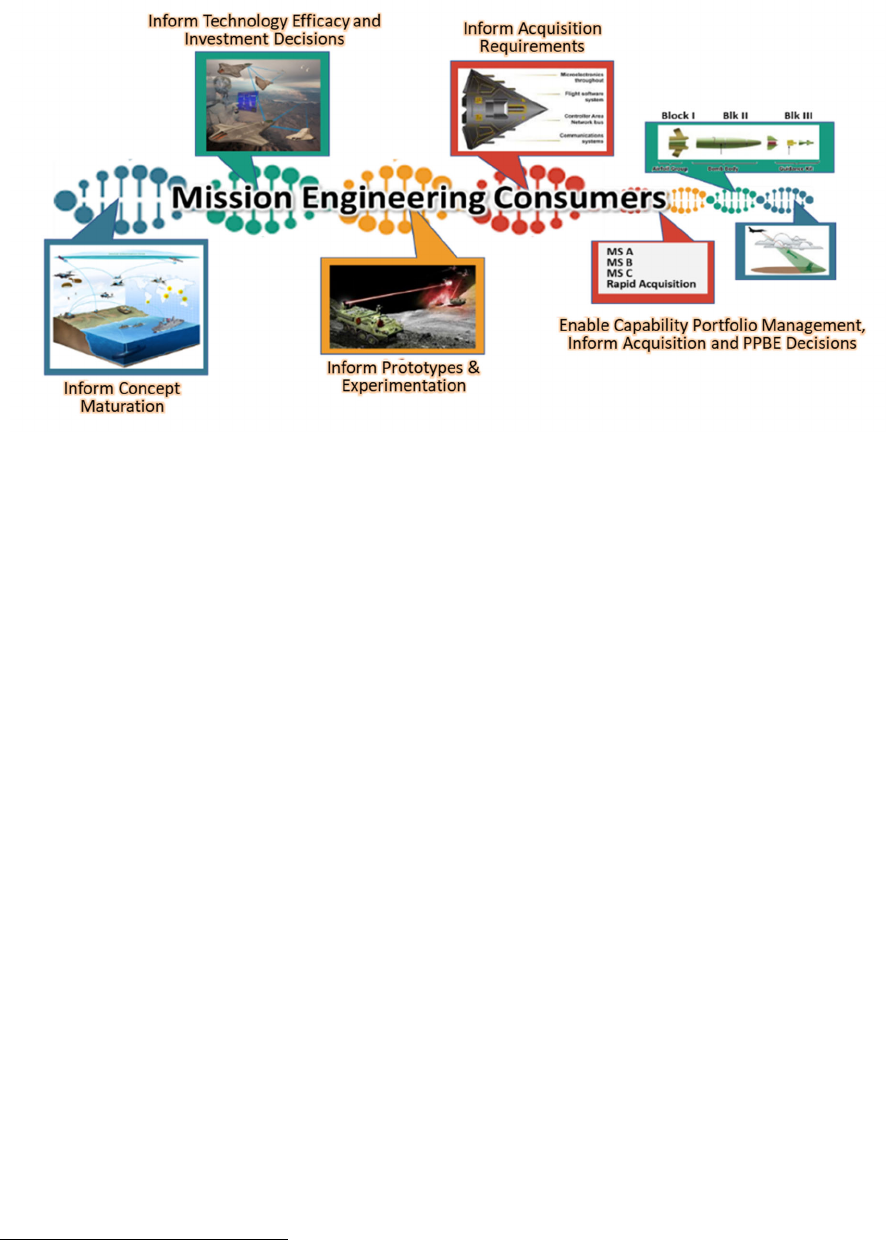
4
Figure 2‐1. Consumers of Mission Engineering Outputs
2.2 Mission Engineering Methodology
Missions are tasks and actions undertaken to achieve a specific objective.
9
The mission engineering
process can be scoped based on the complexity of the mission, the functional mission level (i.e.,
strategic, operational, or tactical), the availability of data, and the decisional needs of the mission
engineering activity. The methodology can be adapted according to practitioners’ goals: to
preemptively identify risks and opportunities for change; to resolve identified issues across a
mission; or to explore potential “what if?” changes to the mission and its operational environment.
The process illustrated in Figure 2-2 is not necessarily a sequence of discrete steps, but it can be
performed iteratively as more information is gained throughout the process. This methodology
should produce repeatable and traceable results and products that can provide justifiable evidence
to advise decision makers, and it should be leveraged to inform subsequent analyses.
9
Department of Defense Dictionary of Military and Associated Terms (formerly Joint Publication 1-02)
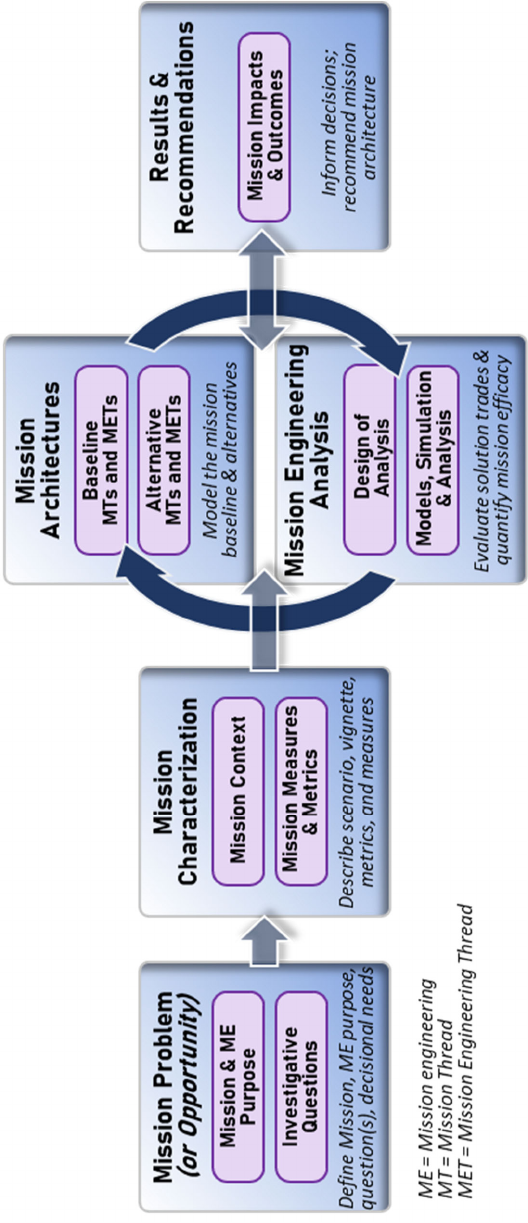
5
Figure 2-2. The elements of the mission engineering process.

6
2.3 Considerations
2.3.1 Digital Engineering in Mission Engineering
Digital engineering principles support a continuum that enables consistency and reuse of models
and data when applied in the mission engineering process.
10
The use of digital representations and
artifacts provides both a technical means to communicate across a diverse set of stakeholders and
the means to deliver data-driven, quantitative outputs resulting in better-informed decisions. With
the use of digital tools and model-based engineering approaches, mission architectures can be
represented as digital mission models within a particular scenario. The use of these tools and
approaches allows for traceability from mission tasks to solutions. These tools also enable the
reuse of products to facilitate updates and changes as needed. Digital linkage and traceability
enable strong configuration management of mission engineering inputs and products. In addition,
the use of general-purpose modeling languages, overlays, styles, and frameworks––e.g., System
Modeling Language (SysML), Business Process Model and Notation (BPMN), Unified
Architecture Framework Modeling Language (UAFML), and Unified Modeling Language
(UML)––enables common understanding, sharing, and reuse of products across the enterprise.
There are a variety of digital tools that can be used to implement mission engineering depending
on the scope, products, and fidelity required. Examples of digital tools include physics-based,
behavior-based, and effects-based simulations, as well as model-based or enterprise architecture
software. These tools provide a quantitative, or computational and logical means, to trace, analyze,
and evaluate a variety of factors that impact the end-to-end mission.
2.3.2 Robustness and Transparency Across the Mission Engineering
Process
The mission engineering methodology is designed to explore multiple options for addressing
mission challenges or seizing opportunities for technology integration across a mission. The
methodology provides a means to compare the effectiveness of alternative mission approaches or
sensitivities around a range of uncertainties to explore the mission space and provide options for
trading capabilities or balancing investments.
To lend transparency to the mission engineering process, practitioners should document
assumptions, constraints, sources of data used, and other factors that drive the results of analysis.
Increased visibility of data, methods, inputs, and factors influencing the design of analysis enables
stakeholders and decision makers to obtain a better understanding of, and confidence in, the
outputs and findings of the activity.
Together, the robustness and transparency of the mission engineering methodology enable
practitioners to obtain a better understanding of each other’s work and increase credibility of the
results.
10
Department of Defense Chief Technology Officer website, “Digital Engineering,”
https://ac.cto.mil/digital_engineering/

7
2.3.3 Reuse––Curation of Data and Products
Without relevant and trustworthy sources of data, completing the mission engineering process may
not even be possible. Based on the complexity and scope of the mission, large datasets may be
needed to characterize the mission and develop the required models for mission engineering—the
development of mission architectures and the execution of mission engineering analysis. The
datasets that support mission engineering analysis include details on the mission and concepts of
operation, operational environment and geographic region, red- and blue-force structures and
orders of battle, and systems or SoS parameters and concepts of employment. A record of other
completed analyses (e.g., engineering-level analyses) that address similar or related topics is
valuable. Practitioners should cast as wide a net as possible across the Department of Defense,
other U.S. Government partners, academia, industry, and the national laboratories for relevant
source data. The collection and storage of data will be an iterative process throughout mission
engineering as more information will be required for different activities and alternative mission
approaches under assessment. Data sources should be credible to ensure validity of the products
developed and that results of appropriate fidelity―i.e., accuracy, precision, and statistical
confidence―are obtained. In the event the necessary datasets are not available, reasonable
assumptions may be required.
Practitioners should consider the following factors when developing datasets for mission
engineering:
Timeliness––When were the data last updated?
Lineage––What is the source of the data? Is the source authoritative?
Fidelity––What is the degree of confidence in the quality of the data?
Validity––Are the data complete? How do the data match agreed-upon definitions?
Linkage––How were the data generated, converted, or collected? With what mission
engineering activity were the data associated?
Storage––How would one catalogue and retrieve the data? With what other datasets are
they topically associated?
Mission engineering adds value to the Department’s engineering, acquisition, and operational
enterprises by facilitating the preservation and maintenance––i.e., the curation
11
––of data products
from current and prior mission engineering activities. Product curation refers to capturing not only
the results and recommendations of a particular analysis, but also to the recording of assumptions,
constraints, sources, models, and data collected. Curation of these elements helps to serve as a
starting point from which subsequent mission engineering activities can be developed.
11
Office of the Undersecretary of Defense for Research and Engineering, “Department of Defense Digital Engineering
Strategy,” June 2018

8
When data is retained, practitioners should clearly
describe the context of the initial use of the data. Doing
so will provide future users with sufficient information
to assess whether reuse of the data is appropriate in a
new context.
Practitioners should consider compiling a library of
models and datasets that are developed and used throughout the mission engineering activity and
should document the source of data. As new information is developed and collected, the data
within the models can be updated to reflect changes in threat, concepts of operation (CONOPS),
and system performance data. The datasets can be generated and collected from wargames,
exercises, developmental and operational tests, experimentation, and demonstrations. For
example, data and results from experimentation provide valuable information on whether the
potential DOTMLPF-P solutions are implementable or have the claimed performance within a
relevant live (physical), virtual, or constructive venue. Over time, properly curated datasets will
yield an increase in the fidelity of the models and results obtained from the mission engineering
activities.
Whilesomegeneralrulesandbest
practicesapply,thepractitioner
willhavetomakeinformed
decisionsregardingwhichdata
assetsareappropriateforreuse.

9
3.0 _MISSION PROBLEM OR OPPORTUNITY
To be effective, the mission engineering process requires thorough planning that focuses on
formulating and agreeing to a well-defined scope for the mission engineering effort. Advanced
planning ensures that the options, parameters, and constraints determined throughout the mission
engineering process stay aligned and can be traced back to the intent of the effort. In addition, a
well-structured plan ensures long-lead-time elements are initiated immediately, and that the overall
implementation and execution of the mission engineering activities are focused and successful.
Therefore, mission engineering begins with defining a clear understanding of its intended purpose,
which, in turn, is informed by a clear understanding of the mission under investigation, its
contextual setting, and its timeframe. Practitioners should capture the purpose in a statement that
synopsizes the mission gaps, problems, or opportunities that drive the effort. This statement of
purpose will inform a set of well-articulated questions that further bound and scope the focus of
the mission engineering activity.
3.1 Identify Mission and Mission Engineering Purpose
Mission engineering starts by identifying two
foundational elements: what is the mission? and what is
to be investigated about that mission? These elements
are crucial to scoping the mission engineering activities
that follow.
The mission engineering purpose—i.e., what is to be
investigated?—can take one of four forms:
Identify potential gaps and quantify shortfalls in the ability to achieve desired mission
outcomes
Explore mission cause-and-effect relationships, or sensitivity analysis, to gain deeper
understanding of the factors affecting mission outcomes
Evaluate trade space of potential solutions to address known gaps within the mission
Investigate mission impact of new opportunities, which can include changes to or the
integration of new technologies, capabilities, or concepts of operations
From the beginning, it’s important to have a clear understanding of what goal or decision will be
informed as this will drive subsequent choices throughout the process. Understanding the
decisional needs focuses the effort to address the so what? of the mission engineering
investigation. These decisions guide the specific questions for the activity as well as the degree of
fidelity and level of analytic rigor needed from the results, findings, and conclusions.
Thepurposeandquestions
boundingthemission
engineeringactivityshould
clearlyarticulateassumptions,
gaps,problems,oropportunities.

10
3.2 Determine Investigative Questions
The purpose statement is amplified by posing one or more key questions that narrow the scope of
the mission engineering effort. Subsequent activities in the mission engineering methodology trace
back to answering these questions. The questions should drive analytic outputs to address the
purpose of the activity—i.e., inform the decisions, trades, and designs. The questions should guide
the selection of alternative mission approaches to be used in the design of analysis and point the
way toward the development of key measures and metrics. As such, these questions should further
refine the fidelity—i.e., the accuracy, precision, and confidence of the analytic outputs and data
inputs. Table 3-1 offers examples of investigative questions aligned with purpose statements.
Table 3-1. Example purpose statements and questions to scope the problem or opportunity.
Example1:Identifycapabilitygaps:Inayear2040BaseDefenseScenariofocusedontheWesternIslands
region,theJointForcewillbeexecutingabasedefensemissionandneedstoachievemissionobjectives(inthis
example,thepurposeistouncovermissioncapabilityshortfalls).
Basedonthecurrentexpected
assetavailabilityandmunitionsinventory,willJointForcebeableto
achieveitsmissionobjectives?
Ifnot,why?WhatarethelimitingfactorsorgapspreventingtheJointForcefromachievingitsmission
objectives?
Example2:Explorecauseandeffect:Inayear2040BaseDefenseScenariofocusedontheWesternIslands
region,evaluatetheJointForce’sabilitytoexecuteabasedefensemissionif25percentofthebluemission
assetsarenotavailable(i.e.,purposeistoinquirehowwelltheJointForcewillmeetmissionobjectives).
Howdoesthemissionoutcomeschangewhenblueassetsarereducedby25percent?
Whatisthesensitivitytoattritionofredasthenumberofblueassetschange(decreaseorincrease)?
Willchangingthenumberofblueassetsincreasetotalsurvivabilityofblueassets?Isthereachangeto
thetotalnumberofweaponsormunitionsexpended?
Example3:Tradesolutionstogaps:Inayear2040BaseDefenseScenariofocusedontheWesternIslands
region,theJointForcelacksPosition,Navigation,andTiming(PNT)capabilitytoperformbasedefensemissions
incontestedenvironments(inthisexample,thepurposeistoevaluatepotentialsolutionsthatclosegapsand
improvemissionoutcomes).
HowisbasedefensemissionsuccessimpactedbyusingalternatePNTtechnologies?
WhatistheperformanceofalternatePNTtechnologiesinadverseenvironmentalconditions?
Example4:Investigateopportunities:Inayear2040BaseDefenseScenariofocusedontheWesternIslands
region,anewcapabilitywillbefieldedtosupportbasedefensemission(inthisexample,thepurposeisto
assessimpactsofmissionwhenintegratingthenewcapability).
IstheJointForcemoreeffectiveinachievingitsobjectivesbyutilizingthiscapabilitycomparedtothe
baselinemissionapproach(theagreeduponstartingpointforhowthemissionwillbeexecutedto
addressthemissionengineeringeffort;drivenbythemission,scenario,andepoch)?
Ismissionsuccessachievedwithreducedweaponexpenditure?Issurvivabilityofplatformsincreased?
Areadditionalcapabilitiesortechnologies(i.e.,enablers)requiredtoemploythiscapabilitysolution?

11
3.3 Identify and Engage with Stakeholders
As the purpose of the mission engineering effort is
developed, practitioners should identify the key
stakeholders who will support the activities.
Stakeholders can be those who are informed by and those
who will use the mission engineering results to support
their efforts or make informed decisions. Stakeholders
can include end-users, sponsors, leaders, and decision
makers.
The identification of new mission capabilities can require the development and alignment of
critical skill sets, subject matter expertise, and personnel resources. Leaders and practitioners
across the enterprise should recognize these needs and coordinate their fulfillment as early as
possible. Effective stakeholder engagement can lead to the identification of subject matter experts
who can support mission engineering efforts with data, information, and the verification and
validation of assumptions.
Stakeholdershelpfocusthe
missionengineeringactivityon
thelevelofconfidenceneededto
addressitspurpose––informing
datacollection,modelfidelity,
andthedesignofanalysis.
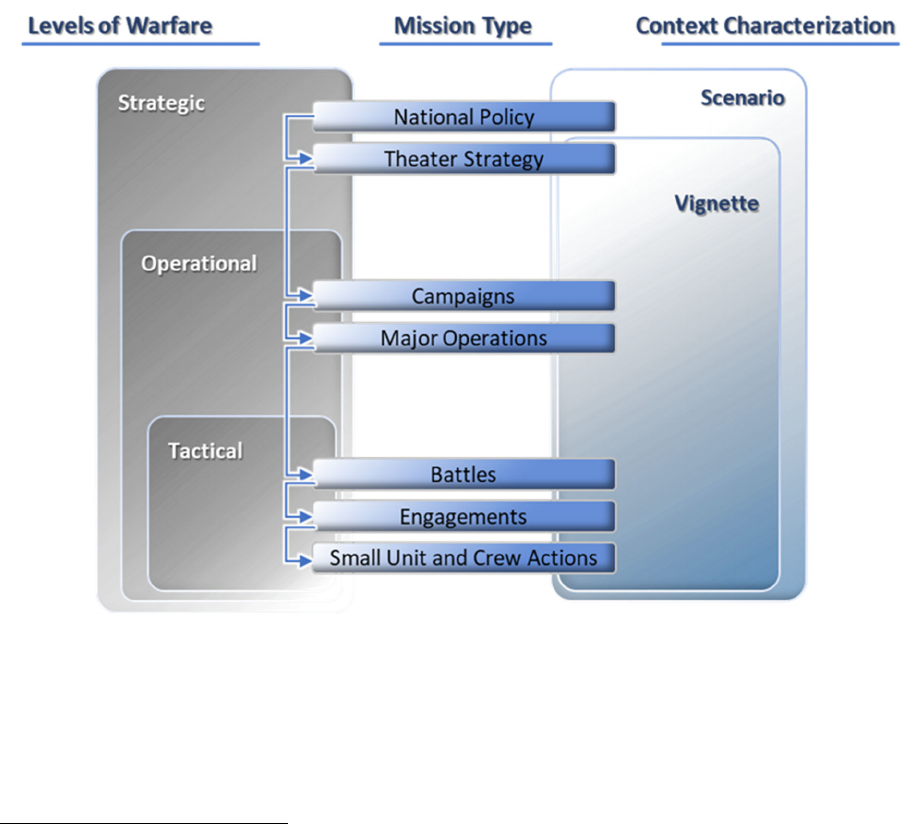
12
4.0 _M
ISSION
C
HARACTERIZATION
The statement of purpose and investigative questions are placed in a specific mission context for
analysis. Missions are purpose-specified tasks and actions to achieve specific objectives.
12
Example sources of missions include Joint Warfighting Concepts, CONOPS, and operational
plans. Mission context is very important; the context provides critical variables that can influence
mission outcomes and decisions. These variables that characterize the mission include objectives,
factors associated with operations, and the conditions of the environment. The mission context
should also include enough information from which to derive mission measures and metrics that
address the investigative questions in the statement of purpose. Additionally, the mission context
should help evaluate the extent to which executing the mission successfully achieves the desired
outcomes and end-state.
Figure 4-1. Generalized hierarchical and overlapping relationships between levels of
warfare, mission type, and context characterization.
12
Department of Defense Dictionary of Military and Associated Terms (formerly Joint Publication 1-02)

13
The Doctrine for the Armed Forces defines the three levels of warfare as
Strategic, operational, and tactical—[that] link tactical actions to achievement of
national objectives. There are no finite limits or boundaries between these levels, but
they help commanders design and synchronize operations, allocate resources, and
assign tasks to appropriate command. The strategic, operational, or tactical purpose
of employment depends on the nature of the objective, mission, or task.
13
With a tendency to overlap, these levels are generally aligned to the context of both the objective
and mission, which are defined by scenarios and vignettes. See Figure 4-1.
4.1 Develop Mission Context
The mission context is the background setting, conditions, timeframe, operational strategies, and
objectives of the mission that are specific to the focus of the mission engineering effort and to
answering the key questions. The collection of this information is known as the scenario, which is
derived from a campaign. The scenario captures the specific description and intent of the mission,
i.e., its objectives and CONOPS, along with its associated epoch and the relevant operational and
environmental conditions. Conditions are descriptive variables of the environment and military
operation that affect the execution of tasks in the context of the assigned mission. Conditions can
be categorized by the following:
Physical environment (e.g., sea state, terrain, or weather)
Operational environment (e.g., the conditions, circumstances, and influences that affect
employment of capabilities and bear on the decisions of the commander)
Functional elements and their relationships (e.g., forces assigned, threats, command and
control, and timing of action)
Informational environment
These sets of conditions can affect execution and mission outcomes. Scenarios can be decomposed
into smaller subsets of factors, which are referred to as vignettes. Vignettes are more narrowly
framed to concentrate on the most important aspects––the phase or segment––of the scenario
related to addressing the investigative questions. The Defense Planning Scenarios and the Joint
Force Operating Scenarios serve as example source documents that can be leveraged to inform the
development of scenarios and vignettes.
The following are some general considerations when characterizing the mission:
What is the purpose of the mission? The mission objectives describe the commander’s intent
and the conditions, situations, and events that constitute success. The purpose of the mission is
often hierarchical––starting with a strategic goal, segmented into operational objectives, and
then refined into the tactical effects of a given scenario or vignette.
When does the mission occur (i.e., in what epoch or timeframe)? The timeframe of the mission
is important to understand the force laydown—the capabilities, technologies, or systems to be
fielded, deployed, and available—and the operational plans and policy implications.
13
Joint Publication 1, “Doctrine of the Armed forces of the United States,” March 25, 2013
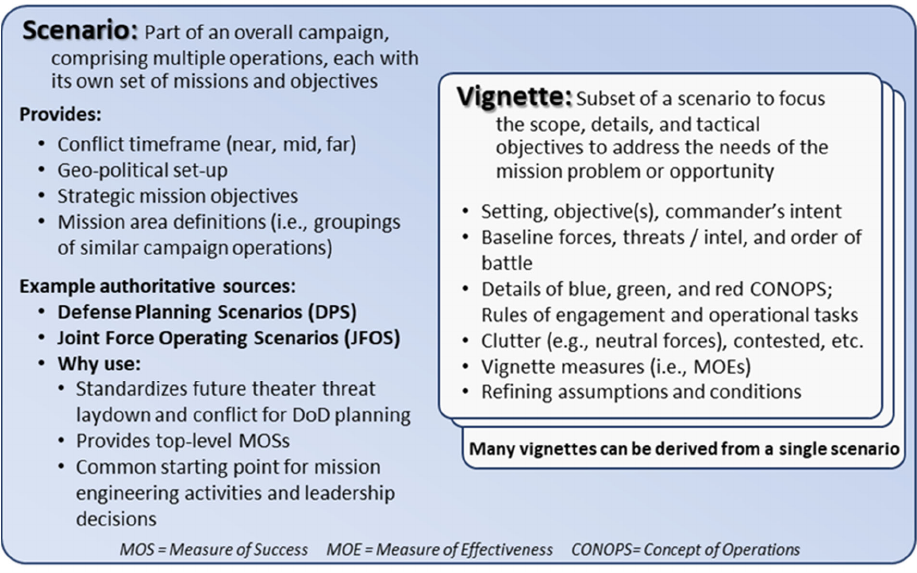
14
Where is the mission happening? What geographic and geopolitical settings are relevant to the
mission? The location of the mission describes not only where the mission takes place (e.g.,
theater, area of operations), but also what geopolitical considerations are relevant to its
execution.
Who is involved (i.e., combatants and noncombatants; friendly, hostile, and neutral forces)?
The description of available forces should include blue (U.S.), green (allies), white
(noncombatants or neutral), and red (adversary) forces as well as orders of battle.
How is the mission executed? The sequence of operational events that will take place to execute
the end-to-end mission (i.e., mission approaches).
Figure 4-2 shows a framework for organizing key elements of the mission context, including the
relationships among characterizing elements, objectives, environments, assumptions, and
constraints that impact mission approaches and systems to be modeled. Practitioners should
document assumptions, constraints, and other limitations that bound the mission context.
Figure 4-2. Overview of Mission Characterization.
4.2 Define Mission Measures and Metrics
Mission measures and metrics are the means to assess the end-state or goals of a given mission
approach and evaluate the elements contributing to mission outcomes. Measures and metrics are
selected from repeatable and unambiguous objective values and threshold values, which most
directly inform the investigative questions and decisions to be addressed by the purpose statement.

15
Measures of Success (MOSs)––measurable attributes or target values for success within the
overall mission in an operational environment that are typically driven by the mission objectives
of the blue force.
Measures of Effectiveness (MOEs)––measurable military effects or target values for success that
come from executing tasks and activities to achieve the MOS.
Measures of Performance (MOPs)––measurable performance characteristics or target parameters
of systems or actors used to carry out the mission tasks or military effect.
For the purposes of mission
engineering, there is a hierarchy of
measures and metrics which provides a
logical decomposition of the ends and
means to accomplish the overall
mission objective and its related tasks.
Typically, there is an overall
operational objective to be evaluated to
determine whether a mission is deemed
successful or not. Measures of success
help quantify this objective, support the
purpose statement, and answer the
investigative questions. These
measures should help to quantify
impacts to the mission outcomes or
end-state. Measures of success could be
derived from source documents
describing specific missions and
scenarios, such as the Defense Planning
Scenario. An example MOS is the Joint
Force shall defeat 70 percent of the
adversary fleet in less than five days.
One or more MOEs help to characterize
the MOS. Measures of effectiveness
provide a means to assess and evaluate
various actors in the execution of their
tasks. Changes to MOEs (e.g.,
improving a given capability) can result in observations and help build understanding of the
sensitivity correlating to the MOS. An example MOE is the number of red assets destroyed and
the number of targets tracked.
14
Air Force Doctrine Publication 3-0, “Operations and Planning,” p. 89, November 4, 2016
ExampleMOSs,MOEs,andMOPs
InaJointForcemissiontostopamajorenemy
groundoffensive,thesuccessofthemission(defined
byMOSs)couldbeassessedbymeasuringthearea
ofthebattlespacestillunderfriendlycontrol.Ifthe
arearemainsunchanged,thentheenemy’s
offensivehasbeenstopped,andthemissionhas
beenasuccess.
AJointForceAirComponentCommander(JFACC)
mightassessmissioneffectiveness(definedby
MOEs)bymeasuringhowmanyofthetargeted
enemyforcescontactedfriendlyforcesincoherent
platoon‐sizeorlargerformations.Ifthatnumberis
small,protectingfriendlytroopsandeffectively
bluntingtheenemyoffensive,[then]theJFACCmay
concludethattheblueforces’effortswere
effective—andthattheydidtherightthing.
TheJFACCmightassess[blue]forceperformance
(definedbyMOPs)bymeasuringthenumberof
interdictionsortiessuccessfullyflownagainstenemy
follow‐onforces.Ifblueforcesflewtheplanned
numberofsortiesormorewithoutloss,theJFACC
canassessthatblueforcesaredoingthingsright.
14
16
The attributes that characterize the specific performance of each actor—i.e., capabilities,
technologies, systems, and personnel in the mission approach—represent one or more MOPs.
Measures of performance are typically measurable data points that are collected and serve as inputs
to support the development and execution of the mission engineering activities. As MOPs are
tracked, there may be correlating changes to the MOEs and MOSs. Example MOPs include missile
speed, range, maneuverability, warhead size, lethality, and survivability.
Measures and metrics should be selected and scoped to the statement of purpose. Measures and
metrics will evolve as factors across the mission becomes more fully understood and as various
potential solutions are investigated. Relevant measures and metrics emerge after identifying: 1)
the purpose statement, investigative questions, and decisional needs; 2) the mission and its
objectives; and 3) the mission approach’s tasks and assigned actors. A high-quality MOS aligns to
the mission of interest and investigative questions associated with the purpose statement. The
MOEs and MOPs are defined and collected, as needed, in direct contribution to the MOS. The
MOEs and MOPs help to explain whether the MOS is being achieved and the factors contributing
to its achievement.
The data and observations gained from obtaining the selected measures and metrics should be
preserved for future analysis, potentially to inform revised baseline mission approaches or to help
accelerate follow-on efforts given what has been previously learned. High-quality measures and
metrics have the following characteristics:
Consistent and repeatable––to grade across subsequent iterations, trades, and alternative
mission approaches
Relevant and necessary––addresses the purpose statement
Solution agnostic––unbiased toward a specific mission approach or solution
Measurable––represents a scale, either directly observed or derived
Figure 4-3 illustrates the linkage of measures and metrics from the system level to the mission
objectives. The MOEs and MOPs connect through the mission architecture—from tasks to
systems, up to the MOSs. This balance ensures the use of valid measures and metrics in the
analysis.
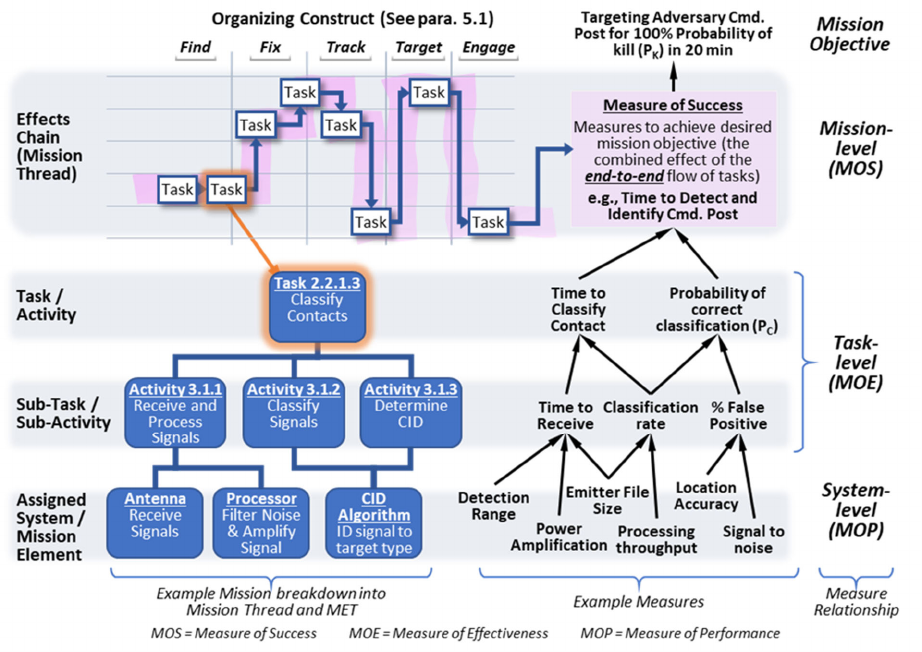
17
Figure 4-3 Linkage of measures and metrics from the system or system of systems to mission
levels.
18
5.0 _MISSION ARCHITECTURES
The architecture of a mission captures the structure of what activities, tasks, and events are
essential to the mission and how these activities are executed to achieve end-to-end mission
objectives. Mission architectures capture the relationships, sequencing, execution, information
exchanges, DOTMLPF-P considerations, and nodal linkages of elements within the mission.
Mission architectures provide a bridge between military operations on one side and functionality
on the other. In addition, mission architectures should reflect tactics and timing to complete the
necessary tasks to achieve mission objectives.
In mission engineering, there are two key elements of mission architectures: 1) mission threads,
which capture the activities of a given mission approach, and 2) Mission Engineering Threads
(METs). These elements capture how the mission activities related to the actors, systems, and
organizations are executed in a specific mission context captured in the scenario and related
vignettes (See Figure 5-1). A mission architecture can be thought of as an interwoven effects web,
or kill web, comprised of many mission threads and METs.
Mission architectures provide the means to compare alternative mission approaches to conduct a
mission against a baseline mission approach. The models and data used to digitally represent
mission architectures should be tailored to suit the level of detail required to address the purpose
statement, investigative questions, and specific mission context of interest. The derivation of
mission threads and METs is an iterative process.
There are multiple ways to document a mission architecture and several notational approaches that
can be used to describe mission threads and METs, including BPMN, UML, SysML, UAFML, or
other Department of Defense standard architecture views.
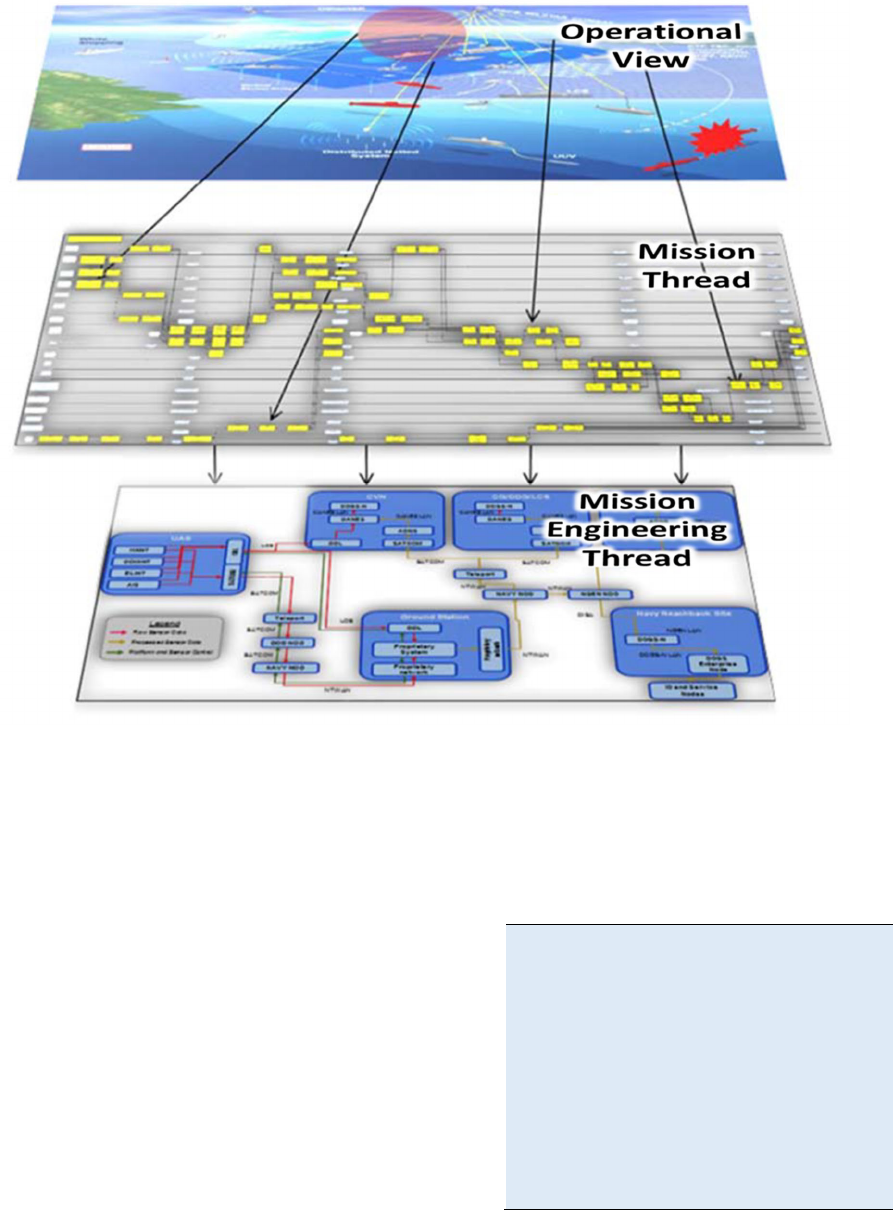
19
Figure 5-1. Relationship of elements in a mission architecture from an operational view
(top, scenario), through an approach (middle, mission thread), to the assignment of actors
and systems (bottom, MET).
5.1 Mission Threads
Mission threads characterize the sequence of events,
activities, decisions, and interactions in an end-to-
end mission approach to achieve an operational
mission objective. Mission threads are distinct in that
they describe the task execution sequence in a chain
of events, not how or by whom each activity within
the flow is to be accomplished.
There is no single source for mission threads;
however, ample resources exist in the Joint Staff,
Services, and Combatant Commands––discussion
with stakeholders and subject matter experts from
these organizations is critical and will help mission engineers properly characterize missions and
develop mission threads. As inputs for mission thread development, practitioners may consider
MissionThreadsdescribeasetof
tasks,activities,andeventsinan
approachtoconductamission.
MissionEngineeringThreadsassign
theactors—people,systems,
organizations,etc.—thatperform
thetasks,activities,andeventsin
theapproachtoconductamission.

20
resources like the Joint Mission Essential Task List (JMETL), the Unified Joint Task List (UJTL),
the Joint Common System Function List (JCSFL), and Service-specific task lists.
In context of a specific scenario, mission threads
describe tasks to be executed, leveraging doctrine,
tactics, techniques, procedures, and associated decision-
making cycles as well as any deviations from the Joint or
Service task lists.
Organizing tasks into a sequential description of the
mission approach is useful. There are several broad constructs that can serve as starting points,
such as the task flow for a long-range fires (kinetic) mission thread may take the form of Find–
Fix–Track–Target–Engage–Assess (F2T2EA). Alternately, logistics and other supporting missions
may take a different construct––for instance, a cyber (non-kinetic) mission thread may follow the
task flow of reconnaissance, weaponization, and delivery, i.e., Exploitation–Installation–
Command and Control (C2)–Action on Objective.
5.2 Mission Engineering Threads
The development of one or more METs will complete the representation of a given mission
approach by adding the details on the actors––systems, technologies, organizations, and
personnel––necessary to accomplish the mission tasks. METs provide insights that inform
engineering designs and development considerations for systems and SoS.
The level of detail provided in a MET should be tailored to the purpose statement. Not all tasks in
the mission thread need to be assigned an actor. Practitioners may make some assumptions
regarding activities and events that are not central to the investigative questions––as long as these
assumptions are explicitly documented. As with mission threads, practitioners should validate
METs with stakeholders and subject matter experts.
Figure 5-2 depicts the relationship between an individual mission thread and a MET. In practice,
the execution of a mission in a specific scenario may include the integration of multiple mission
threads and METs as effects webs or kill webs. Practitioners should ensure that a complete set of
threads and its associated relationships are represented in the mission architecture based on the
purpose and scope of the mission engineering effort.
Practitionersshouldvalidate
derivedmissionthreadswith
stakeholdersandsubjectmatter
experts.
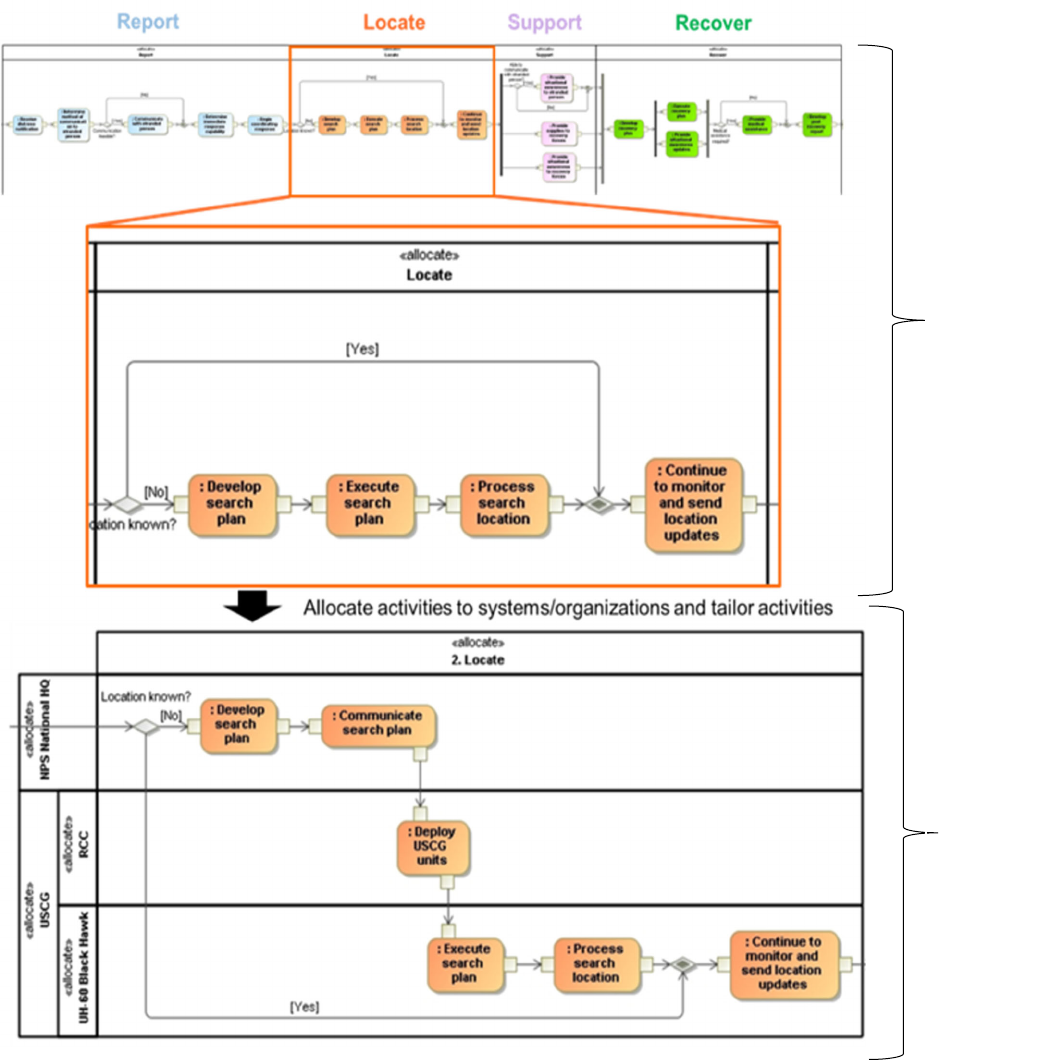
21
Figure 5-2. Example of a single mission thread and associated MET modeled in digital
engineering tool.
Mission
Thread
MET
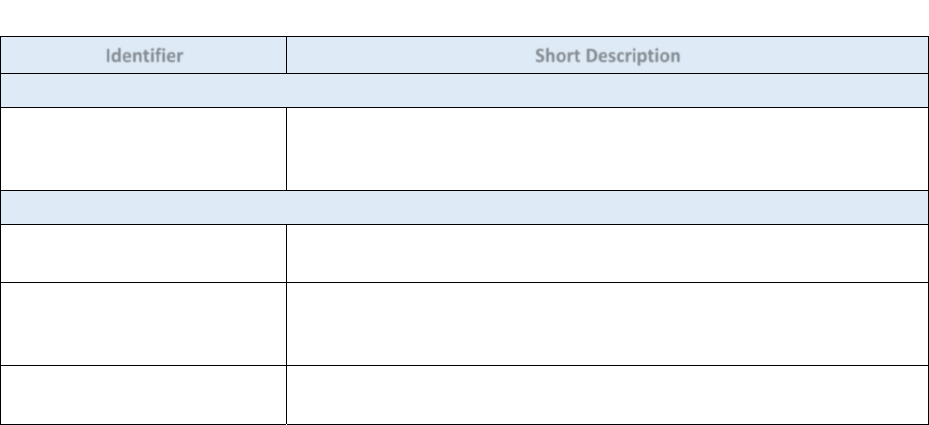
22
5.3 Develop Baseline and Alternative Mission Threads and
Mission Engineering Threads
The mission threads and METs against which alternative mission approaches will be assessed are
called the baseline mission approach. Typically, the baseline is a starting point, or an initial
approach to the mission for the epoch (present or near future) of interest. When considering new
ways to improve mission outcomes, those changes should be represented by adding the modified
activities to the mission threads or by integrating the new technologies or systems to the METs.
These changes become alternative mission approaches. These alternatives are excursions from the
baseline mission approach, directly derived from the purpose statement and the investigative
questions. For example, if the mission engineering purpose is to explore cause and effect, then the
alternatives could be driven by a sensitivity to a particular parameter. If the purpose is to address
potential solutions or new opportunities, then the alternatives could model the implementation of
the driving forces behind those opportunities. In addition, alternatives can be chosen based on
known issues or gaps identified from the baseline. For each alternative, practitioners may need to
develop and validate separate METs (and possibly mission threads). Each baseline and alternative
MET should be clearly documented with controlled configurations. The documentation should
reflect any associated changes, including traceable sources of information and references.
To be most effective in interpreting results of the mission engineering activity, practitioners should
clearly understand and capture the changes being made between the baseline and alternative
mission approaches. Depending on the scope of the mission engineering activity, changes could
be focused on a single system or SoS within the baseline. Alternative mission approaches may
become new baselines for subsequent mission engineering efforts.
For illustration, Table 5-1 provides examples of baseline and alternative mission approaches when
considering an opportunity statement that is focused on understanding the mission impacts of
integrating new weapon systems with associated enhancements and enablers.
Table 5-1. Approaches to be examined
Identifier ShortDescription
BaselineApproach
A. ConventionalApproach EmployGlobalPositioningSystem(GPS)‐guidedstandoffmissilesfromblue
forcebomberaircraft,supportedbyjammersandaerialrefueling,toattack
redforceaircraft
AlternativeApproaches&Excursions
B1.Bomber‐launchedglide
vehiclewithGPS
Substitutenewbomber‐launchedglidevehicleweapon,GPS‐guided
B2.Surface‐launchedglide
vehiclewithGPS
Excursion:Substitutelaunchplatformtoemploysameglidevehicleweapon
fromapproachB1,butlaunchedatextendedrangefromSurfaceShip,GPS‐
guided
C.Bomber‐launchedsubsonic
cruisemissilewithGPS
Substitutenewbomber‐launchedsubsoniccruisemissile,GPS‐guided
As already noted, mission architectures include mission threads and METs executed in the
specific mission context. The interdependencies revealed across this mission architecture
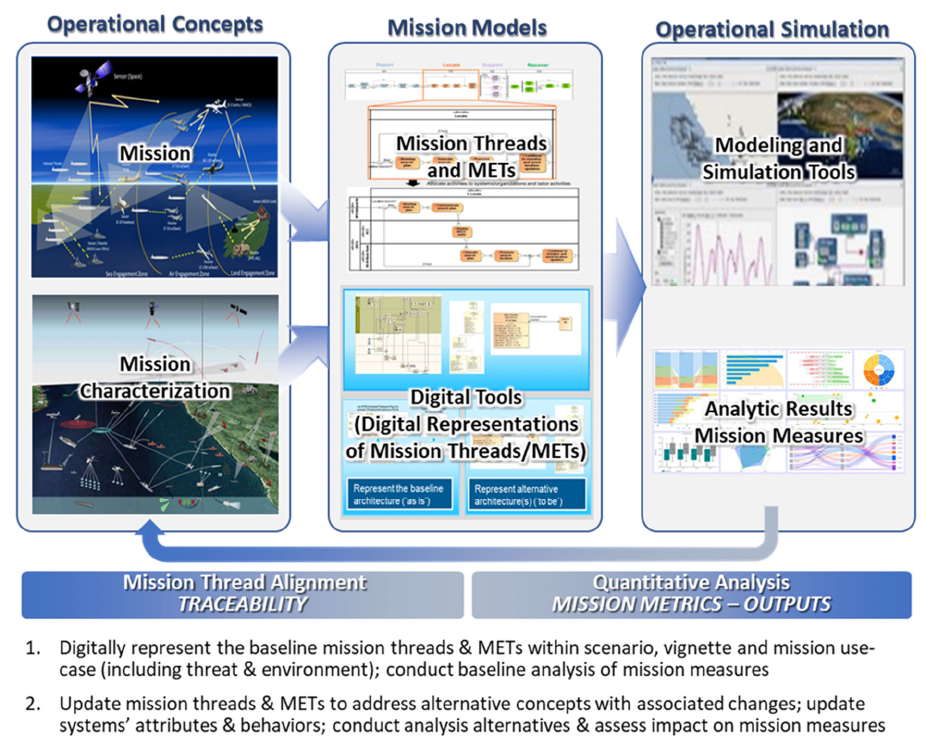
23
underscore the importance of reflecting all METs applicable within the scenario. This set of
integrated METs should be traceable to the mission engineering analysis and can serve as the
blueprint for further mission engineering activity as depicted in Figure 5-3.
Figure 5-3. Mission architectures are traceable to the mission engineering analysis.
24
6.0 _MISSION ENGINEERING ANALYSIS
The core function of mission engineering analysis is to evaluate mission architectures within the
specific scenario-based mission context to provide quantitative outputs (i.e., measures and metrics)
that explore mission success. The analysis focuses on simulating the behaviors and effects of
executing the mission—the baseline and alternative mission approaches—amid potential
variations in conditions to assess mission impacts.
In conducting analysis of mission architectures, practitioners can benefit from expertise in systems
engineering (e.g., reliability engineering or risk management) and related processes, such as failure
mode and effects analysis, to assess the impact of system or task failure on the overall mission.
Powered by constructive simulations and predicated on operations research, mission engineering
analysis provides quantitative measures and metrics based on mission execution. The results can
inform the refinement and modifications to the mission architectures.
6.1 Complete Design of Analysis
A mission engineering analysis should be designed such that its outputs are provided to address
the purpose statement and answer the investigative questions. Some key aspects of the design of
analysis include:
Development of a run matrix
Identification of the appropriate computational and simulation analysis tools
Refinement of datasets
6.1.1 Develop and Organize Evaluation Framework (Run Matrix)
A run matrix is a structured set of mission approaches to be analyzed in a specified mission
scenario or vignette for the mission engineering analysis. The matrix should include the mission
baseline approach and various alternatives for comparison. Based on the questions to be addressed,
excursions should reflect the varying considerations and changing variables within the mission
context and baseline mission approach. The practitioner may consider identifying alternative
approaches to be explored based on known issues or gaps identified from the baseline. These
alternatives are the changes in the METs, described in Section 5.3. The run matrix is a useful way
to plan analysis and inform the selection of analytical approaches.
The primary elements of the run matrix are the mission approaches to be evaluated and the
operational conditions that may impact performance. For each entry in the run matrix, practitioners
should consider the availability of datasets and the fidelity and statistics needed from models and
simulations. Assumptions, limitations, and boundary conditions imposed on the run should be
included. Practitioners should also weigh the analytic methods and modeling tools appropriate to
obtain meaningful results.
Run matrices begin with trials, or excursions, associated with the baseline approach. Practitioners
should validate run matrix with stakeholders and subject matter experts. Boundary conditions,
constraints, and limitations associated with each conducted run should be captured. Practitioners
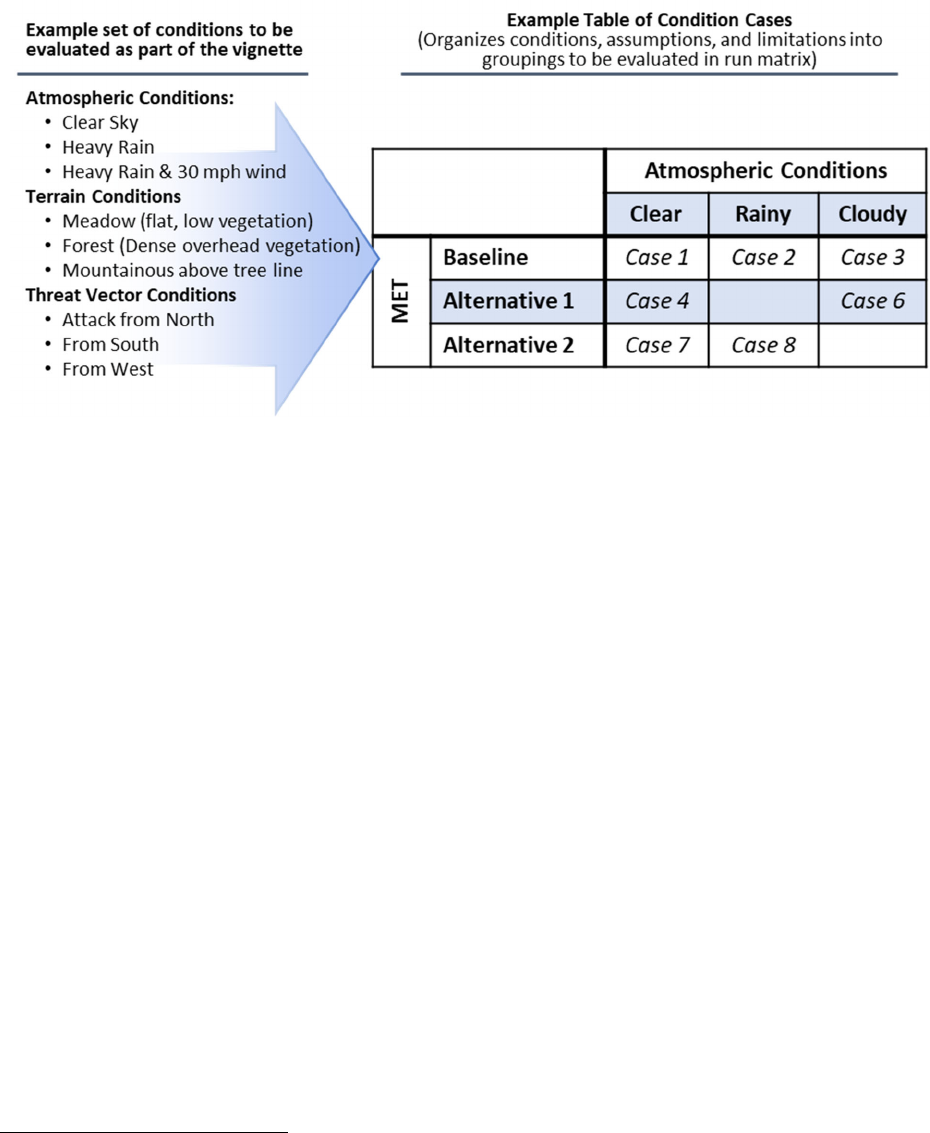
25
may find a tabular format, such as that shown in Figure 6-1, can be a useful way to summarize and
organize relevant information derived from the run matrix.
Figure 6-1. Illustrative grouping of cases and set-up conditions.
15
6.1.2 Identify Computational Methodology and Simulation Tools
There are many analytical methods to assess the different mission approaches in the run matrix.
Practitioners should select the method most appropriate to the mission engineering purpose and
investigative questions. Potential methods include:
Bayesian analysis
Markov chain
Monte Carlo simulation
Regression analysis
Optimization analysis
Sensitivity analysis
Cost-benefit analysis
Stochastic modeling
Empirical modeling
Parametrization
Some instances of when to apply these methods for implementing mission engineering include
using optimization analysis to help find the best value for one or more variables under certain
constraints; using sensitivity analysis to determine how variables are affected by changes in other
variables; and using parametrization to express system, process, or model states as functions of
15
Author’s note: depending on the mission engineering effort, not all cases may need to be executed.
26
independent variables. The application of these methods can help refine assumptions and inputs
when more than one variable is unknown.
The investigative questions, the measures and metrics, and the selected type of analysis will drive
the practitioner to choose the appropriate analytic tools for modeling and computing the run matrix
to assess mission impacts. As is the case with the selection of analytical methodology, practitioners
should select tools that best support the mission engineering activity. In selecting tools,
practitioners should account for the computational time of each trial, which is determined by the
model and analytic complexity, against the total time allotted for the mission engineering analysis.
Potential tools for mission engineering application include both government-owned and
commercial modeling, simulation, and architecture software. These tools enable the development
of models and the execution of analysis at the strategic, operational, and tactical levels and in
different domains (e.g., maritime, air, land, and space). These tools also enable analysis of different
mission operations––including electromagnetic, cyber, communications, jamming, and non-
kinetic versus kinetic operations—with different degrees of computational rigor, fidelity, or
complexity.
The choice of tools is driven by the complexity of the scenario, vignette, and mission threads.
Other factors influencing the choice of tools include the mission duration and computational
timesteps, the fidelity requirements of the data, and the number of variables feeding the measures
and metrics. The models derived from the selected toolset will handle error propagation (e.g.,
random and systematic) and uncertainty differently. Practitioners should understand the tools and
the relationship between a model and the pedigree of source data necessary to effectively use that
model.
6.1.3 Organize and Review Datasets
Much of the data needed for the analysis has been collected thus far from mission characterization
and the development of mission architectures. The different baseline and alternative options within
the run matrix will structure the analysis and may require additional data to develop models for
the simulation and analysis. Therefore, organizing and reviewing the data collected will help assess
additional data needs for the mission engineering effort. Datasets should come from trustworthy
data sources and be reviewed by subject matter experts to lend credibility to the models,
simulations, and results.
6.2 Execute Models, Simulations, and Analysis
Using the run matrix developed, practitioners should execute the simulation for the baseline and
alternative mission approaches to output results––mission measures and metrics. Depending on
the scope of the mission engineering activity, the baseline mission approach could be executed
before fully defining the run matrix to identify gaps or mission areas with which to focus
alternatives. Once processed and verified, the results will provide quantitative insights describing
the impact of the approaches on mission outcomes.
27
Practitioners should consider the following in the execution of modeling runs:
Executing and analyzing the baseline mission approach
Adjusting the run matrix, as necessary
Executing and analyzing the alternative mission approaches
Validating the analytic findings
6.2.1 Execute and Analyze the Baseline
Practitioners should model the baseline MET within the context of the scenario and vignette using
the tools to simulate and execute the mission. All relevant peoples and organizations, system
attributes, behaviors, and effects should be represented. Practitioners should conduct baseline
trials, as planned in the run matrix. The baseline runs should be critically examined to ensure the
modeled MET has captured known operational behavior and that simulation results match the
judgement of subject matter experts. In most cases, more information is known about the baseline
than the proposed alternative mission approaches, allowing practitioners to more readily check
that the models and analytic tools will deliver results consistent with expectations. Practitioners
should document mission measures and metrics, observations, and assumptions.
6.2.2 Adjust the Run Matrix (as Needed)
If unexpected results or additional gaps are discovered with the baseline output, practitioners
should consider adjusting the run matrix with appropriate alternative METs. It is more efficient to
adjust the run matrix at this stage than to wait until all trials have been run. Once adjustments are
made, practitioners should revalidate the run matrix with subject matter experts.
6.2.3 Execute and Analyze the Alternative Mission Approaches
Practitioners should model the alternative METs within the context of the scenario and vignette
using the chosen tools to simulate and execute the mission. Special cases should be noted,
including when runs do not go as predicted, where statistical convergence is not achieved, and
where models and simulations unexpectedly crash or yield an interesting singularity. Practitioners
should rerun trials where needed and record all encountered anomalies and events occurring within
the runs. Practitioners should capture mission measures and metrics, and observations or
assumptions. Interesting and unexpected results can be the source of excursions, variations on the
mission threads and METs, or further sensitivity analysis around specific parameters. Finally,
practitioners should document results for all entries in the run matrix.
6.2.4 Validate the Fidelity of Analytic Results
Three important considerations in any mission engineering analysis are:
Accuracy—systematic error, random error, anomalies, and artifacts
Precision—error analysis and statistical regression

28
Confidence—the interval, or range of possible values for a given parameter based on a set
of data, e.g., simulation results and the level or probability that the interval contains the
value of the parameter
Before executing additional analyses, practitioners should first evaluate whether the results from
the initial trials yield the fidelity—the accuracy, precision, and confidence—needed to answer the
investigative questions. With actual values now available for review, measures and metrics
identified as important in the design of the analysis may not be as hard-hitting as initially thought.
Other critical measures and metrics might have been overlooked. The aggregation of measures and
metrics should be reviewed to ensure findings will support the conclusions that inform
stakeholders and decision makers.
Practitioners should critique the results for both proper
execution of the analytic methods as well as the
soundness of results. The results should be graphed or
visualized to inspect the output. Practitioners should
assess whether the comparison of baseline and
alternative mission approaches has meaning and to
obtain insights on the impacts of changes to mission outcomes. Example questions that
practitioners should confidently answer include:
Does the comparison of results from the baseline to the alternative mission approach trials
yield quality data sufficient to answer the investigative questions?
Are the results of these trials, i.e., the measured performance of the mission approach,
justifiable and explainable as a narrative and consistent with input from subject matter and
operational experts?
How do the assumptions and constraints for the analysis, impact the interpretation of the
results?
Do the results address the investigative questions in a way that meaningful conclusions can
be drawn?
6.3 Adjust Mission Threads and Mission Engineering Threads
If answers to these questions are inadequate, or if other behaviors of interest are observed, then
practitioners should revisit the cycle of mission thread and MET development. Further adjustments
to the run matrix and trials may need to be made. The cycle follows the following pattern:
Observe the mission
Conject a reason for that observation
Create an alternative mission approach to evaluate that conjecture
Evaluate if the conjected case confirms the observation (i.e., fully answers the investigative
questions)
If the case does not confirm the observation, then repeat the cycle
Practitionersshouldreviewthe
analyticfindingswith
stakeholdersandsubjectmatter
experts.
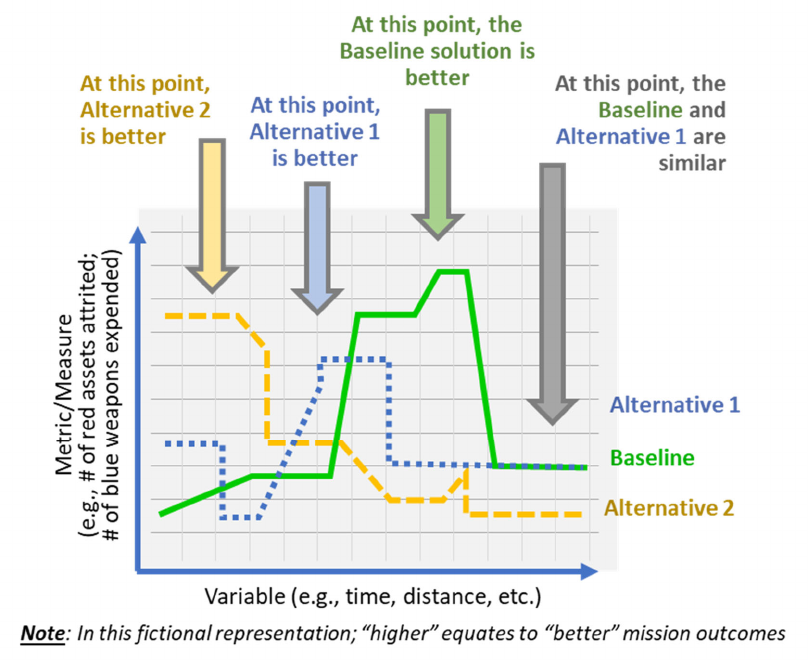
29
7.0 _R
ESULTS AND
R
ECOMMENDATIONS
The final phase of the mission engineering process comprises three elements: 1) synthesis and
documentation of mission impacts and outcomes obtained from the mission engineering analysis,
2) the capture and presentation of recommended mission architectures, and 3) the curation of
mission engineering artifacts for future use.
The products of mission engineering help focus attention on a set of recommendations associated
with the purpose statement and investigative questions. Recommendations are used to inform
leadership, shape requirements, advise prototyping efforts, and substantiate acquisition decisions.
Recommendations help explain the attributes of recommended mission architectures, reflect the
MOSs as aligned with the original questions and highlight the need for further analyses.
Major mission engineering products include:
Digital models of mission architectures—mission threads and METs
Collection of information on missions, scenarios, and current and future capabilities
Datasets—system performance parameters, models, metrics, and measures
Documented results, findings, and recommendations—visualizations, reports, briefs, digital
artifacts
Figure 7-1. Example visualization of results from mission engineering analysis.
30
At a minimum, mission engineering products should document the overall purpose of the analysis
and its planning. The products also should include the influences that drove the selection of an
analytic framework––including assumptions and constraints, tools, models, measures and metrics,
and the results obtained. Practitioners should quantify the gain or loss toward the MOSs and other
key measures and metrics that help address the purpose statement. Identify any secondary, or new,
mission gaps that were discovered or could emerge from an implemented solution. Observed
trends or implications and relationships or correlations deduced from the data should be included.
When documenting the overall mission engineering effort, practitioners should consider the
following outline of desirable points:
State the problem or opportunity, the questions, and the mission
Describe the scenario and vignettes, to include describing the operational environment
Identify blue- (U.S.), red- (adversary), and green- or other non-adversary forces as well as
DOTMLPF-P considerations
Delineate measures and metrics for the mission (MOSs, MOEs)
Describe the mission architectures—the baseline, alternative mission threads and METs
Identify key assumptions and constraints about the mission, technology, or capabilities
Document details of the baseline mission approach and related condition cases
Explain the analytical methodology
Describe the results obtained from the analysis citing the fidelity and credibility of the
models, data, and results
Identify any non-error propagated uncertainties or other issues with the results
Justify or explain the fidelity of the results with a statistical basis
Describe the conclusions from the analysis and discuss how the results address the problem
or opportunity statement
Identify and capture risks in each mission architecture
Recommend actions for decision makers
Recommend further analysis and next steps
31
8.0 _SUMMARY
The mission engineering process helps practitioners decompose missions into constituent parts and
analyze end-to-end mission execution. The process helps to identify and resolve capability gaps
and quantify impacts of alternative mission approaches. The process assesses systems or SoS
within that mission context and enables exploration of trade-space opportunities across that
mission.
The mission engineering process can help decision makers align resources to desired mission
outcomes by identifying the most promising potential materiel or non-materiel solutions and
opportunities. The goal of mission engineering is to engineer missions by identifying the right
things—the technologies, systems, SoS, or processes—to achieve the intended mission outcomes;
and provide mission-based inputs into the systems engineering process to aid the Department in
building things right.
The mission engineering process is scalable to the problem or opportunity under evaluation, the
availability of data, and decisional needs. This flexible, iterative methodology allows analysis to
improve as information is gained throughout modeling and simulation runs, providing traceability
to data sources, assumptions, and constraints.
Mission engineering uses mission architectures to analyze the design and integration of systems,
SoS, and emergent capabilities within the context of a particular operational scenario and
vignette to yield desired mission outcomes. The results of mission engineering analyses inform
decision makers on potential trade-spaces in resource allocation to ensure the Warfighters will
have the capabilities, technologies, and systems they need to successfully execute their missions.
Simultaneously, mission engineering informs the evolution of requirements, system design, and
capability development via performance measures.
32
9.0 _APPENDIX
9.1 Mission Engineering Glossary
Alternative Mission Approach: A change to the baseline mission approach for how the mission
will be executed. (OUSD(R&E))
Assumption: A specific supposition of the operational environment that is assumed true, in the
absence of positive proof, essential for the continuation of planning. (JP 5-0, Department of
Defense Dictionary)
Baseline Mission Approach: The agreed upon starting point for how the mission will be
executed to address the mission engineering effort; driven by the mission, scenario, and epoch.
(OUSD(R&E))
Blue Force: U.S. combatants. (OUSD(R&E))
Capability: The ability to complete a task or execute a course of action under specified
conditions and level of performance. (CJCSI 5123.01H, DAU Glossary)
Concept of Operations (CONOPS): A verbal or graphic statement that clearly and concisely
expresses what the commander intends to accomplish and how it will be done using available
resources. (JP 5-0, Department of Defense Dictionary)
Constraint: In the context of planning, a requirement placed on the command by a higher
command that dictates an action, thus restricting freedom of action (JP 5-0 Department of
Defense Dictionary). Constraints may also refer to the range of permissible states for an object
(Department of Defense CIO architecture Framework)
Data Curation: The ongoing processing and maintenance of data throughout its lifecycle to
ensure long-term accessibility, sharing, and preservation. (National Library of Medicine)
Digital Engineering: Digital engineering is an integrated digital approach using authoritative
sources of system data and models as a continuum throughout the development and life of a
system. (OUSD(R&E))
Epoch: A time period of static context and stakeholder expectations, similar a snapshot of a
potential future. For acquisition planning, three epochs are usually defined: 1) near term––up to
two years into the future 2) FYDP (Future Years Defense Program), up to five years into the
future, and 3) beyond the FYDP, 5–10 years into the future. (Naval Postgraduate School; MIT)
Fidelity: A measure of the accuracy, precision, and statistical confidence to which the data,
result, etc. represents the state and behavior of a real-world object or the perception of a real-
world object, feature, condition, or chosen standard in a measurable or perceivable manner.
Green Force: Allied combatants. (OUSD(R&E))
33
Kill Chain: A Mission Thread with a kinetic outcome. Dynamic targeting procedures often
referred to as F2T2EA by air and maritime component forces; and Decide, Detect, Deliver, and
Assess methodology by land component forces. (JP 3-09)
Kill Web: An inclusive set of multiple integrated Mission Threads and METs for the applicable
scenario or vignette of interest. (OUSD(R&E))
Measure: The empirical, objective, numeric quantification of the amount, dimensions, capacity,
or attributes of an object, event, or process that can be used for comparison against a standard or
similar entity or process. (AFOTECMAN 99-101; Science Direct)
Measure of Effectiveness (MOE): Measurable military effects or target values for success that
are derived from executing tasks and activities to achieve the MOS. (OUSD(R&E))
Measure of Performance (MOP): Measurable performance characteristics or target parameters
of systems or actors used to carry out the mission tasks or military effect. (OUSD(R&E))
Measure of Success (MOS): Measurable attributes or target values for success within the
overall mission in an operational environment. Measures of success are typically driven by the
mission objectives of the blue force). (OUSD(R&E))
Metric: a unit of measure that coincides with a specific method, procedure, or analysis (e.g.,
function or algorithm). Examples include mean, median, mode, percentage, and percentile.
(AFOTECHMAN 99-101)
Mission: The task, together with the purpose, that clearly indicates the action to be taken and the
reasoning behind the mission. (JP 1-02)
Mission Architecture: A view or representation that depicts the ways and means to execute a
specific end-to-end mission, with relationships and dependencies amongst mission elements.
This includes elements such as mission activities, approaches, systems, systems of systems,
organizations, and capabilities. (OUSD(R&E))
Mission Characterization: The aggregate of factors associated with military objectives and
operations; this includes the mission to be accomplished in a specific time and place, the
measures of success, the threats, and constraints. Changes in any factors of the mission
characterization may cause the mission to be redefined. (OUSD(R&E))
Mission Context: The elements that describe who, what, when, where, and why elements of the
mission to be accomplished. Changes in any elements of the mission context may cause the
mission to be redefined. (OUSD(R&E))
Mission Element: A person, organization, platform, and/or system that performs a task.
(OUSD(R&E))
Mission Engineering: An interdisciplinary process encompassing the entire technical effort to
analyze, design, and integrate current and emerging operational needs and capabilities to achieve
desired mission outcomes. (OUSD(R&E))
34
Mission Engineering Analysis: The approach to evaluate mission architectures within the
specific scenario-based mission context to provide quantitative outputs that explore mission
impacts. (OUSD(R&E))
Mission Engineering Thread (MET): Mission threads that include the details of the
capabilities, technologies, systems, and organizations required to execute the mission.
(OUSD(R&E))
Mission Tasks: A clearly defined action or activity specifically assigned to a system, individual
or organization that must be complete. (Adapted from JP-01).
Mission Thread: A sequence of end-to-end mission tasks, activities, and events presented as a
series of steps to achieve a mission. (OUSD(R&E))
Model: A physical, mathematical, or otherwise logical representation of a system, entity,
phenomenon, or process. (DoDI 5000.61, DoDI 5000.70) per MSE. Per the Systems Engineering
Body of Knowledge, Models are often categorized as Descriptive, Analytic, etc. (Systems
Engineering Body of Knowledge)
Operations: 1. A sequence of tactical actions with a common purpose or unifying theme. (JP 1)
2. A military action or the carrying out of a strategic, operational, tactical, service, training, or
administrative military mission. (JP 3-0, Department of Defense Dictionary) There are
Operations–sequences of tactical actions with a common purpose or unifying theme; Major
Operations–series of tactical actions to achieve strategic or operational objectives; and
Campaigns–series of related major operations aimed at achieving strategic and operational
objectives within a given time and space. (JP-1)
Planning, Programming, Budgeting, and Execution (PPBE) Process: The primary resource
allocation process of Department of Defense. (DAU Glossary)
Red Force: Adversary combatants. (OUSD(R&E))
Scenario: Description of the geographical location and timeframe of the overall conflict. A
scenario includes information such as threat and friendly politico-military contexts and
backgrounds, assumptions, constraints, limitations, strategic objectives, and other planning
considerations. (OUSD(R&E))
Sensitivity Analysis: Determines how different values of an independent variable affect a
particular dependent variable under a given set of assumptions. (Investopedia website,
https://www.investopedia.com/terms/s/sensitivityanalysis.asp)
Tactical: The level of employment, ordered arrangement, and directed actions of forces in
relation to each other, to achieve military objectives assigned to tactical units or task forces
(TFs). (Adapted from JP 3-0, Chapter 1, 6.d.)
Threat: The sum of the potential strengths, capabilities, and strategic objectives of any
adversary that can limit U.S. mission accomplishment or reduce force, system, or equipment
effectiveness. The threat does not include (a) natural or environmental factors affecting the
35
ability or the system to function or support mission accomplishment, (b) mechanical or
component failure affecting mission accomplishment unless caused by adversary action, or (c)
program issues related to budgeting, restructuring, or cancellation of a program. (DAU Glossary,
CJCSI 5123.01H)
Verification: The process of determining that a model or simulation implementation and its
associated data accurately represent the developer's conceptual description and specifications.
(JP 3-13.1, Department of Defense Dictionary)
Validation: The process of determining the degree to which a model or simulation and its
associated data are an accurate representation of the real world from the perspective of the
intended uses of the model. Applicable to an expressed user need and consistent with program
concept of operations. (Space and Missile Systems Center Mission Engineering Primer and
Handbook)
Vignette: A narrow and specific ordered set of events, and behaviors and interactions for a
specific set of systems, to include blue force capabilities and red force (threats) within the
operational environment. Vignettes can represent small, ideally self-contained parts of a
scenario. (OUSD(R&E))
White Force (White Units): Non-combatant or neutral units. (OUSD(R&E))
36
9.2 Abbreviation List
C2 Command and Control
CCMD Combatant Command
CJCSI Chairman of the Joint Chiefs of Staff Instruction
CONEMP Concept of Employment
CONOPS Concept of Operations
DAU Defense Acquisition University
DOTMLPF-P Doctrine, Organization, Training, Materiel, Leadership and Education, Personnel,
Facilities, and Policy
DoD Department of Defense
DoDD Department of Defense Directive
DoDI Department of Defense Instruction
DPG Defense Planning Guidance
F2T2EA Find, Fix, Track, Target, Engage, Assess
FY Fiscal Year
FYDP Future Years Defense Program
GPS Global Positioning System
JFACC Joint Force Air Component Commander
JFOS Joint Force Operating Scenario
JP Joint Publication
MEG Mission Engineering Guide
MET Mission Engineering Thread
MT Mission Thread
MIM Mission Integration Management
MOE Measure of Effectiveness
MOP Measure of Performance
MOS Measure of Success
M&S Modeling and Simulation
NDS National Defense Strategy
37
NMS National Military Strategy
OOB Order of Battle
OSD Office of the Secretary of Defense
Pk Probability of Kill
PNT Position, Navigation, and Timing
PPBE Planning, Programming, Budgeting, and Execution
SE Systems Engineering
SoS Systems of Systems
SysML System Modeling Language
TTP Tactics, Techniques, and Procedures
UAFML Unified Architecture Framework Modeling Language
UJTL Universal Joint Task List
UML Unified Modeling Language
USD(R&E) Under Secretary of Defense for Research and Engineering
U.S. United States
38
9.3 References
Advisory Panel on Streamlining and Codifying Acquisition Regulations (Section 809 Panel),
Report Volume III, July 2019
CJCSI 3030.01, “Implementing Joint Force Development and Design,” December 3, 2019
CJCSI 3500.02C, “Universal Joint Task List Program,” August 15, 2023
CJCSI 5123.01H, “Charter of the Joint Requirements Oversight Council (JROC) of the Joint
Capabilities Integration and Development System (JCIDS),” August 31, 2018
Joint Publication 1, “Doctrine for the Armed Forces of the United States,” July 12, 2017
Joint Publication 3-09, “Joint Fire Support,” April 10, 2019
Joint Publication 3-30, “Joint Air Operations,” July 25, 2019
Joint Publication 3-85, “Joint Electromagnetic Spectrum Operations,” May 22, 2020
Joint Publication 5-0, “Joint Planning,” June 16, 2017
Chief Information Officer Website, “Architecture Framework,” website
https://dodcio.defense.gov/Library/DoD-Architecture-Framework/dodaf20_glossary/
Defense Acquisition University (DAU) website, https://www.dau.edu/tools/t/DAU-Glossary
Defense Technical Cooperation Program, Guide for Understanding and Implementing Defense
Experimentation (GUIDEx), February 2008
Department of Defense Directive 5137.02 “Under Secretary of Defense for Research and
Engineering (USD(R&E)),” July 15, 2020
Department of Defense Instruction 5000.DE, “Digital Engineering Implementation,”
forthcoming
Department of Defense Instruction 5000.88, “Engineering of Defense Systems,” November 18,
2020
Friedenthal, S.; Moore, A.; and Steiner, R., A Practical Guide to SysML, 3rd Edition, 2014
Kenton, Will, “Sensitivity Analysis Definition,” Investopedia website,
https://www.investopedia.com/terms/s/sensitivityanalysis.asp
National Research Council, Defense Modeling, Simulation, and Analysis: Meeting the Challenge,
2006
Office of the Chairman of the Joint Chiefs of Staff, “Department of Defense Dictionary of
Military and Associated Terms,” current edition
Office of the Chairman of the Joint Chiefs of Staff, “Manual for the Operation of the Joint
Capabilities Integration and Development System,” current edition
39
Office of the Deputy Secretary of Defense, Memorandum “Principles and Standards for Analysis
Supporting Strategic Decisions,” February 2, 2022
Office of the Under Secretary of Defense for Acquisition, Technology, and Logistics, Report to
Congress, “Mission Integration Management,” March 2018
Office of the Under Secretary of Defense for Research and Engineering, “Department of Defense
Digital Engineering Strategy,” June 2018
Office of the Undersecretary of Defense for Research and Engineering, Department of Defense
Engineering of Defense Systems Guidebook, February 2022
Public Law 114-328, “National Defense Authorization Act for Fiscal Year 2017,” December 23,
2016
Public Law 116-617, “National Defense Authorization Act for Fiscal Year 2021,” January 1,
2021
USAF Space and Missile Systems Center, Systems Engineering Primer and Handbook, 2nd
Edition, 2004
USAF Doctrine Publication 3-0, “Operations and Planning,” November 4, 2016

40
Department of Defense
Mission Engineering Guide
Office of the Under Secretary of Defense for Research and Engineering
3030 Defense Pentagon
Washington, DC 20301
https://ac.cto.mil/mission-engineering/
For any questions, please contact: [email protected].
Distribution Statement A. Approved for public release. Distribution is unlimited.
DOPSR Case No. 23-S-3518.
